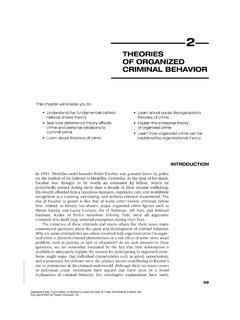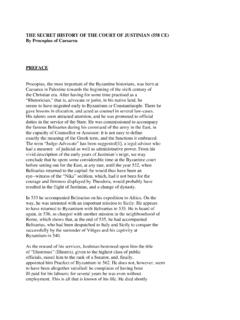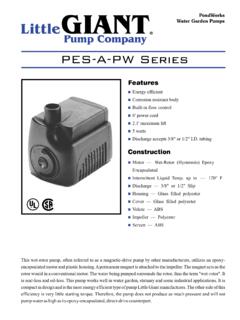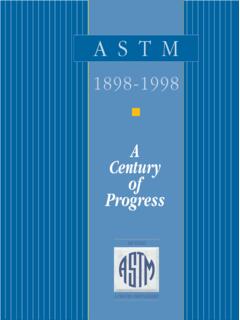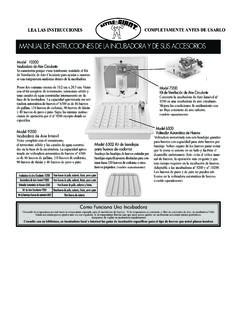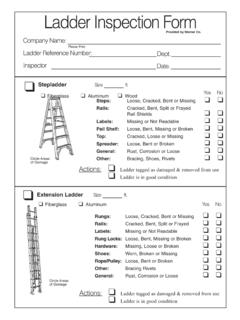Transcription of CHAPTER 18 An Industrial Giant - Pearson
1 26 CHAPTER 18 An Industrial Giant ANTICIPATION/REACTION Directions: Before you begin reading this CHAPTER , in the column entitled Anticipation place a check mark beside any of the following seven statements with which you now agree. When you have completed your study of this CHAPTER , come back to this section and in the column entitled Reaction place a check mark beside any of the statements with which you then agree. Note any variation in the placement of check marks from Anticipation to Reaction and explain why you changed your mind. Anticipation Reaction 1. _____ Between 1870 and 1900, led by businessmen, _____ 1.
2 Americans glorified material wealth. 2. _____ In the late nineteenth century, the United States _____ 2. national economy was characterized by the de- centralization of wealth and ever-expanding opportunit ies for all. 3. _____ The first big business in the United States was _____ 3. the steel industry, made possible by the invention of the Bessemer process and the organizational skills of Andrew Carnegie. 4. _____ Thomas Edison invented, patented, and profited _____ 4. from the typewriter, telephone, and incandescent light bulb. 5. _____ Late-nineteenth-century reformers in the United _____ 5. States blamed the uneven distribution of wealth in the nation on the federal tax system and the growing power of federal regulatory commissions.
3 6. _____ Early national labor unions found it hard to _____ 6. curry public support because they planned and participated in violent labor-management confrontations like the Haymarket riot. 7. _____ The American Federation of Labor (AFL) enjoyed _____ 7. solid and growing support at the end of the nine- teenth century because it denounced the strike as a tool for winning concessions from management. 27 LEARNING OBJECTIVES After reading CHAPTER 18 you should be able to: 1. Evaluate the importance of railroads to the development of the national economy in the late nineteenth century. 2. Describe the impact of Andrew Carnegie in the establishment of the steel industry, and compare it to the impact of John D.
4 Rockefeller in the petroleum industry; focus on why concentration was the tendency in these and other enterprises in the late nineteenth century. 3. Assess the traditional support for free enterprise among late-nineteenth-century Americans, along with their interest in government regulation of business. 4. Compare and contrast the ideas of Henry George, Edward Bellamy, and Henry Demarest Lloyd, and compare and contrast their ideas to those of late-nineteenth-century Marxian socialists. 5. Elaborate the conditions that gave rise to labor unions and labor violence in the late nineteenth century. CHAPTER OVERVIEW Essentials of Industrial Growth Between the end of the Civil War and the beginning of the twentieth century, the United States was transformed into a world Industrial power at a pace not previously seen in history.
5 Great Britain and Germany, the most prosperous European nations, lagged behind the United States. The gross national product increased by 44 percent between 1874 and 1883. The consequences for the nation s po lit ical inst itutions were profound. The discovery of new natural resources, a vigorous and expanding population, foreign investment capital, and a growing national market shielded by protective tariffs all contributed to the flourishing of manufacturing enterprise. In the name of progress, business glorified material wealth. Such attitudes produced a generation of robber barons who, in their search for wealth, engaged in such corrupt practices as stock manipulation, bribery, cutthroat competition, and monopoly.
6 Many immigrants viewed America as a land of opportunity, though some became mired in grinding poverty and struggled for survival in dreary, unhealthy living conditions. New machinery increased productivity in industry and agriculture, but it also displaced increasingly dependent workers and farmers. Expanded industry affected nearly everyone, making available such consumer goods as packaged cereals, canned foods, ready-made clothing, and cigarettes. The perfection of the typewriter revolutionized the performance of office work. George B. Eastman pioneered the development of mass-produced film and the simple but efficient Kodak camera. Railroads: The First Big Business Railroads were probably the most significant element in American economic development in the last quarter of the nineteenth century.
7 With high fixed costs, railroads needed to carry as much 28traffic as possible in order to net a profit, so they constructed feeder lines to draw business to the main trunk lines. Among the first railroads was Cornelius Vanderbilt s New York Central, which ultimately operated between New York City and the principal midwestern cities. Thomas Scott s Pennsylvania Railroad also linked Philadelphia and Pittsburgh to several midwestern cities. The Baltimore and Ohio railroad also gained access to Chicago, which became the nation s railroad hub. In the Southwest, Jay Gould consolidated the Kansas Pacific, Union Pacific, and Missouri Pacific.
8 In the Northwest, Henry Villard and James J. Hill built their respective Northern Pacific and Great Northern. Northern capitalists controlled most trunk lines in the South. Railroads charged what the market would bear, more for manufactured goods and less for bulky products like wheat or coal. The railroads stimulated the economy, particularly in rural areas with undeveloped resources. Technological advances in railroading such as the air brake, steel track, and Pullman sleeping car also accelerated economic development. To speed the settlement of new regions, the land-grant railroads sold land cheaply and on easy terms. They offered reduced rates to travelers interested in buying farms. Iron, Oil, and Electricity The Giant steel industry that emerged after the Civil War was a result of the Bessemer process, perfected independently by Henry Bessemer of Great Britain and William Kelly of Kentucky.
9 Steel could be mass-produced in locations near the Mesabi iron-ore fields of Lake Superior and the coal deposits surrounding Pittsburgh. Petroleum production, pioneered in the drilling of a well in Pennsylvania by Edwin L. Drake, provided lubricants and kerosene decades before gasoline was needed to power the internal combustion engine. The telephone and electric light were two other technical advances meant to serve a high-speed, urban civilization that put great stress on communication. Alexander Graham Bell s telephone successfully competed against Western Union s telegraph. By 1900, American Telephone and Telegraph dominated the phone business. At Menlo Park, New Jersey, Thomas Edison built the prototype of the modern research laboratory from which came patents on the phonograph, motion picture projector, storage battery, mimeograph, and incandescent light bulb.
10 In 1882, Edison opened a power station in New York and successfully demonstrated that electricity could be a substitute for steam power in factories, and the electric power industry expanded rapidly. Competition and Monopoly: The Railroads Economies of large-scale operations, the cost of new machine technology, and the downward trend in prices after 1873 (deflation) created intense competition in the railroad industry. This led to ownership of the railroads concentrating in fewer hands. According to classical economists, competition advanced the public interest by keeping prices low, but, in practice, it also cut deeply into railroad profits, causing the lines to try to increase the volume of goods they hauled.


